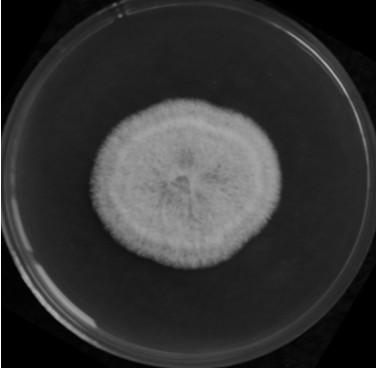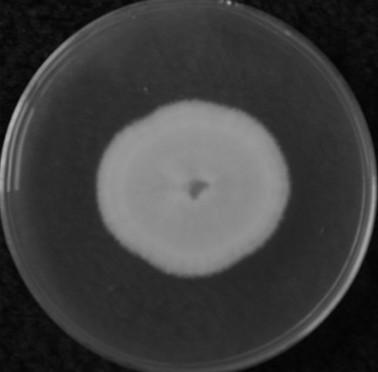Clonostachys rosea and solid fermenting agent and application thereof
A technology for solid fermentation of S. pink, applied in the field of solid fermentation inoculants and S. pink, can solve the problems of complicated production process, complicated screening of bio-control bacteria, chemical control of pollution, etc. Conducive to application and promotion, the effect of large spore production
- Summary
- Abstract
- Description
- Claims
- Application Information
AI Technical Summary
Problems solved by technology
Method used
Image
Examples
Embodiment 1
[0043] Example 1: Identification of Gliocladium rosea
[0044] The inventor isolates and obtains a strain of microbial strain from root-knot nematode, named NF-06, and its identification result is as follows:
[0045] (1) Morphological identification
[0046] The front of strain NF-06 as figure 1 shown, the back as figure 2 As shown, conidiophores and conidia such as image 3 shown.
[0047] It can be seen from the figure that the colony edge of the strain NF-06 on the PDA medium is neat, the hyphae are creeping, relatively loose, white in the initial stage, and light pink in the later stage, and orange-red pigment is produced at the bottom of the colony. The mycelium of strain NF-06 has a septum, and the conidiophores grow directly from the mycelium, colorless, with broom-like branches at the top, and small stalks at the ends of the meristems, which are in the shape of an Anto bottle, and conidia are born on The top of the small stalk is long oval, the size is 2.0~3.5 ...
Embodiment 2
[0051] Embodiment 2: Detect the parasitic effect and lethal effect of NF-06 bacterial strain on second instar larvae of root-knot nematode
[0052] The FF-128 strain is a strain of Gliocladium pink isolated from tomato root soil in the greenhouse of Luowang Township, Xiangfu District, Kaifeng City, Henan Province in March 2017 by the inventor (Jie Zhang). It has a strong inhibitory effect on tomato gray mold and watermelon wilt.
[0053]In this experiment, the G. pinkia FF-128 strain was used as the control, and the lethal and parasitic effects of the strain NF-06 and the strain FF-128 on the second instar larvae of Meloidogyne incognita were respectively determined.
[0054] The specific steps are as follows: Inoculate the bacteria cake (9mm) of strain NF-06 and strain FF-128 into water agar medium, culture at 25°C for 3 days, place four sterile small coverslips around the colony, and 10 μL nematode solution (2000 strips / mL) was dripped onto the cover slip, the petri dish wa...
Embodiment 3
[0057] Embodiment 3: Preparation of Gliocladium pink strain NF-06 solid fermentation inoculum
[0058] (1) Preparation of the seed liquid of Glioma rosea strain NF-06
[0059] Glioma pink strain NF-06 was activated on PDA solid medium and cultured at 25°C for 5 days;
[0060] Divide the prepared PD medium into 250ml Erlenmeyer flasks with 50ml per bottle, autoclave at 121°C for half an hour and then use it for later use. Use a hole puncher on the ultra-clean workbench to make diameters along the edge of the activated colonies. The 5mm fungus cake was inoculated onto the PD medium with an inoculation needle, and cultivated at 25°C and 180r / min for 48 hours to obtain a seed liquid.
[0061] (2) Screening of basal medium
[0062] Using wheat bran, wheat straw, and soybean meal as basic medium raw materials, screen the basic medium, as shown in Table 1, with an initial water content of 40%, inoculate at an inoculum size of 3% (wt / wt), pH 6.5, 25°C The concentration of spores pe...
PUM
 Login to View More
Login to View More Abstract
Description
Claims
Application Information
 Login to View More
Login to View More - R&D
- Intellectual Property
- Life Sciences
- Materials
- Tech Scout
- Unparalleled Data Quality
- Higher Quality Content
- 60% Fewer Hallucinations
Browse by: Latest US Patents, China's latest patents, Technical Efficacy Thesaurus, Application Domain, Technology Topic, Popular Technical Reports.
© 2025 PatSnap. All rights reserved.Legal|Privacy policy|Modern Slavery Act Transparency Statement|Sitemap|About US| Contact US: help@patsnap.com



